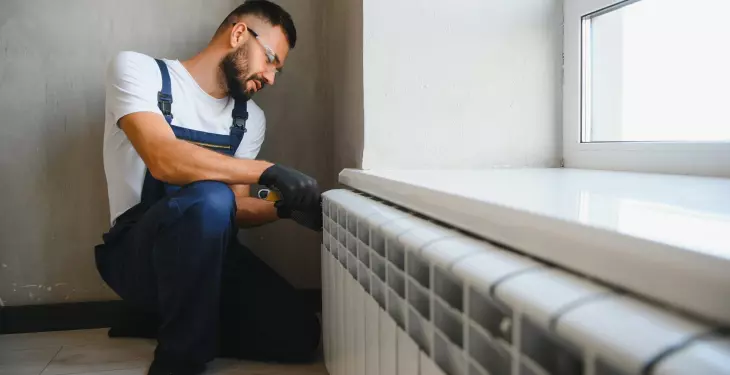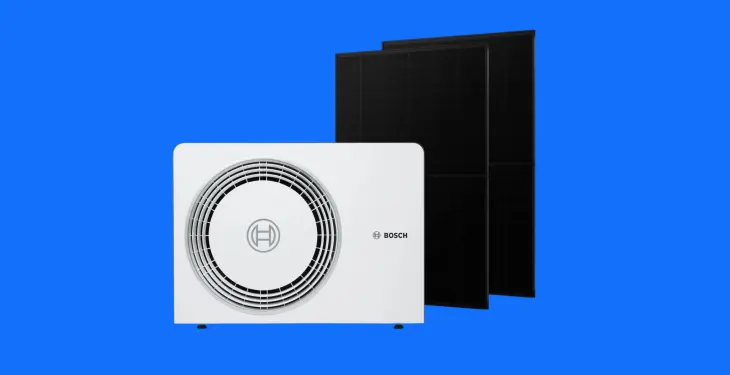

Written by Stephen Day
Gas Safe Engineer
Updated: 30th May, 2025
Choosing between a monobloc and a split heat pump depends on several factors. Key considerations include the size of the home, the type of installation, and the home's heating needs.
See how much you could save with a heat pump quote.
Choosing between monobloc and split heat pumps is a key decision for anyone looking to improve their home's heating and cooling. These two types of air source heat pumps may sound similar, but they have important differences that can affect how well they fit your space and needs. The best system for your home depends on the layout, available indoor space, and how simple or complex your installation needs to be.
Homeowners often find that monobloc heat pumps are easier to install, since all components are housed in a single outdoor unit. Split systems may suit homes that need a more flexible or complex setup, as some parts are placed inside and others outside. Understanding how each system works and their pros and cons can help you make the best choice for your house heating.
A monobloc heat pump is a type of air-to-water heat pump with all main components housed in a single unit. This unit is installed outdoors, so there is no need for a separate indoor unit.
The monobloc system works by absorbing heat from the air outside. It then transfers this energy into water, which can be used for central heating systems or for producing hot water.
Monobloc heat pumps are often used with underfloor heating systems. They provide a consistent and efficient source of warmth, especially in modern or well-insulated homes.
Key Points:
All components in one outdoor unit
No refrigerant pipework inside the home
Connects directly to central heating and hot water systems
Feature | Monobloc Heat Pump |
Main location | Outdoor |
Components | Combined in one unit |
Suitable for | Most homes, space-saving |
Hot water support | Yes, through system connection |
Works with underfloor heating | Yes |
Monobloc systems are generally simple to install. The installer only needs to connect the unit to the home's water network. Because the refrigerant never enters the house, safety requirements are not as strict as with some other systems.
They are often chosen when indoor space is limited, or when a straightforward heating and hot water solution is needed.
A split system heat pump splits the main components between two units: an outdoor unit and an indoor unit. This design is common in many modern homes across the UK.
The outdoor unit is usually placed outside the house. It contains the compressor and heat exchanger, which are key for capturing heat from the air.
The indoor unit is installed inside the home. It connects to the outdoor unit using insulated pipes that carry refrigerant. The indoor unit delivers warm air or water for heating.
Key features of split system heat pumps:
Flexible Installation: The separate units can be placed in different locations, making them suitable for more complex property layouts.
Noise Reduction: As noisy components are outside, indoor noise is minimal.
Variety of Applications: They can heat both air and water, and are used for underfloor heating or radiators.
Component | Location | Function |
Outdoor Unit | Outside | Absorbs and releases heat |
Indoor Unit | Inside Home | Distributes heat to the home |
Split systems provide reliable heating and cooling for homes. The two-part design can also improve system performance, especially in larger houses or buildings with unique layouts.
Monobloc and split system heat pumps both help heat and cool homes, but they are built differently and work in unique ways. The main differences are in their design, parts, and installation needs.
A monobloc heat pump keeps all key components—compressor, refrigerant circuit, expansion valve, fan, heat exchanger, and water pump—in a single outdoor unit. Water flows between the pump and the house. No refrigerant pipes need to go indoors, making installation simple and quick.
In a split system heat pump, the main parts are split into two units: one outdoor and one indoor. The compressor, fan, and part of the refrigerant circuit stay outside. The indoor unit houses the heat exchanger, expansion valve, and sometimes an electric heater. Refrigerant pipes connect the two units, and careful installation is needed to avoid leaks.
Table: Main Differences
Feature | Monobloc System | Split System |
Main Units | One outdoor | Outdoor + Indoor |
Installation | Simple, faster | More complex |
Piping | Water pipes only | Refrigerant pipes |
Noise | All noise outside | Some indoor noise possible |
Night Mode | Quieter at night (outdoor) | May need extra settings |
Risk of refrigerant leak | Low | Higher (due to indoor pipes) |
Many monobloc units have all valves and controls inside the main case. This protects them from weather and helps with maintenance. In split systems, some controls may be indoors, so it is important to have easy access.
Some split systems feature extra options like a built-in electric heater for very cold weather. Monobloc types sometimes need a separate electric backup.
Choosing between these types depends on what features, space, and installation conditions each home has.
Monobloc heat pumps are a popular option for many homes because they have all their main components inside a single outdoor unit. This makes installation faster and simpler than split systems.
Advantages of Monobloc Heat Pumps:
Easier Installation: The monobloc system usually only needs water pipes to connect to the home’s heating system. No refrigerant lines are needed indoors.
Lower Cost: Monobloc heat pumps often have lower upfront costs than split systems.
Space Saving: All parts are outside, so they free up indoor space. There is no need for an indoor heat pump unit.
Quiet Operation: Placing the whole system outside can make homes quieter as the noise stays outside.
Monobloc heat pumps can also supply domestic hot water, but a hot water cylinder is still needed inside the home for storage.
Disadvantages of Monobloc Heat Pumps:
Location is Important: These units work best when installed close to the heating system to shorten pipe lengths.
Cold Weather Performance: Heat loss can be a problem in very cold weather, especially with long water pipes outside.
Limited Customisation: Split systems may allow more flexibility in tricky or large installations.
Feature | Monobloc Heat Pump |
Installation Complexity | Lower |
Indoor Space Needed | Minimal |
Initial Cost | Generally Lower |
Maintenance Access | All outside |
Noise Indoors | Very Low |
Cold Weather Performance | Can be weaker |
A monobloc heat pump is often chosen for its convenience and simpler setup, but it may not be right for every home, especially those with unusual layouts or extra-large heating needs.
Split system heat pumps use two separate units: one outside and one inside the home. The main components are divided, making installation more flexible.
Advantages:
Flexible Installation: The outside and inside units can be placed up to 75 metres apart, allowing them to fit complex homes or buildings.
Quiet Operation Inside: The noisier compressor is kept outside, so living spaces are quieter.
Better for Large Homes: Split systems can handle heating and cooling for bigger properties well.
Disadvantages:
More Complicated Installation: Professional installation is required, and pipework between units can be challenging, especially in older buildings.
Higher Maintenance Cost: Multiple components mean more parts to maintain and repair. Costs can be higher than for simpler systems.
Running Costs: Efficiency is good, but if there's a long connection between the units, energy loss may occur, raising running costs.
Feature | Benefit | Drawback |
Flexible installation | Can suit more homes | May need longer pipework |
Quiet indoors | Comfortable | Compressor noise outside |
Size options | Fits large houses | Needs more space outside |
Regular checks and timely servicing help keep maintenance cost under control. Choosing the best location for both units can maximise efficiency and reduce running costs for a split heat pump system.
Choosing between a monobloc and a split heat pump depends on several factors. Key considerations include the size of the home, the type of installation, and the home's heating needs.
Monobloc systems are often simpler to install. All components are contained in one outdoor unit, so there is less work needed indoors. This makes monobloc heat pumps a good option for new builds or simple modernisation projects where space inside the house is limited.
Split systems have parts both inside and outside the house. This allows for more flexibility, but installation is usually more complex and may need a qualified engineer to handle refrigerant connections. These systems are often chosen for homes with unique layouts or for extensive modernisation where more control is needed over the heating system.
Feature | Monobloc Heat Pump | Split Heat Pump |
Installation | Easier, faster | More complex |
Space Needed Indoors | Minimal | More |
Maintenance | Generally simpler | May require more |
Suitable For | New builds, straightforward modernisations | Bigger homes, challenging layouts |
Energy efficiency is high for both systems, but home layout and installation type can tip the balance. For most standard homes, a monobloc system may be the easiest fit.
Homes with challenging layouts or special needs might gain more from a split system. A professional installer can help decide which type fits your home best.
Both monobloc and split system heat pumps can heat a home efficiently and improve air quality. The main differences are in how they are set up and where the units go. Choosing between them often comes down to the layout and needs of the property.
A monobloc heat pump is a single, self-contained unit placed outside the house. These are usually easier and faster to install, with less disruption indoors. They are also well-suited for most standard homes.
A split system heat pump has two parts: one outside and one inside. This system can be a better option for homes with more complex heating requirements. It may also be chosen when space around the house is limited.
Key Differences Table
Feature | Monobloc | Split System |
Number of Units | One (outdoor only) | Two (indoor & outdoor) |
Installation | Simpler, quicker | May require more time |
Suitable for | Most homes | Complex or unique setups |
Footprint | Larger outdoor unit | Smaller outdoor, indoor unit |
Homeowners should think about available space, the complexity of their heating system, and how much disruption they can manage during installation. Either option can bring energy savings and comfort with proper use.
Last updated: 30th May, 2025

Written by Stephen Day
Gas Safe Engineer at iHeat
Stephen Day is a Gas Safe registered and FGAS certified engineer with over 20 years of hands-on experience in the heating, cooling, and renewable energy industry, specialising in boiler installations, air conditioning, and heat pump systems.
LinkedInArticles by Stephen Day are reviewed by iHeat’s technical team to ensure accuracy and reliability.

05th December, 2025
Most homes need some radiators upgraded for a heat pump, but usually not all of them.
 Read Article
Read Article

05th December, 2025
Most homes can lower heating costs by combining air source heat pumps with solar panels.
 Read Article
Read Article

28th November, 2025
High temperature heat pumps work like boilers without needing radiators, but they cost mor...
 Read Article
Read Article
No obligation. Takes less than 60 seconds.